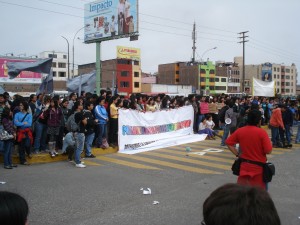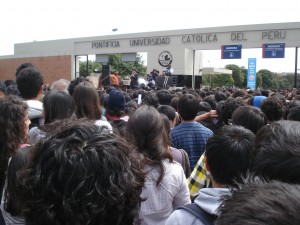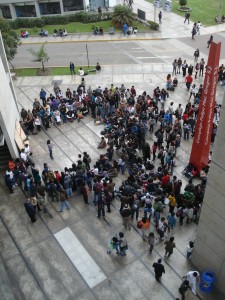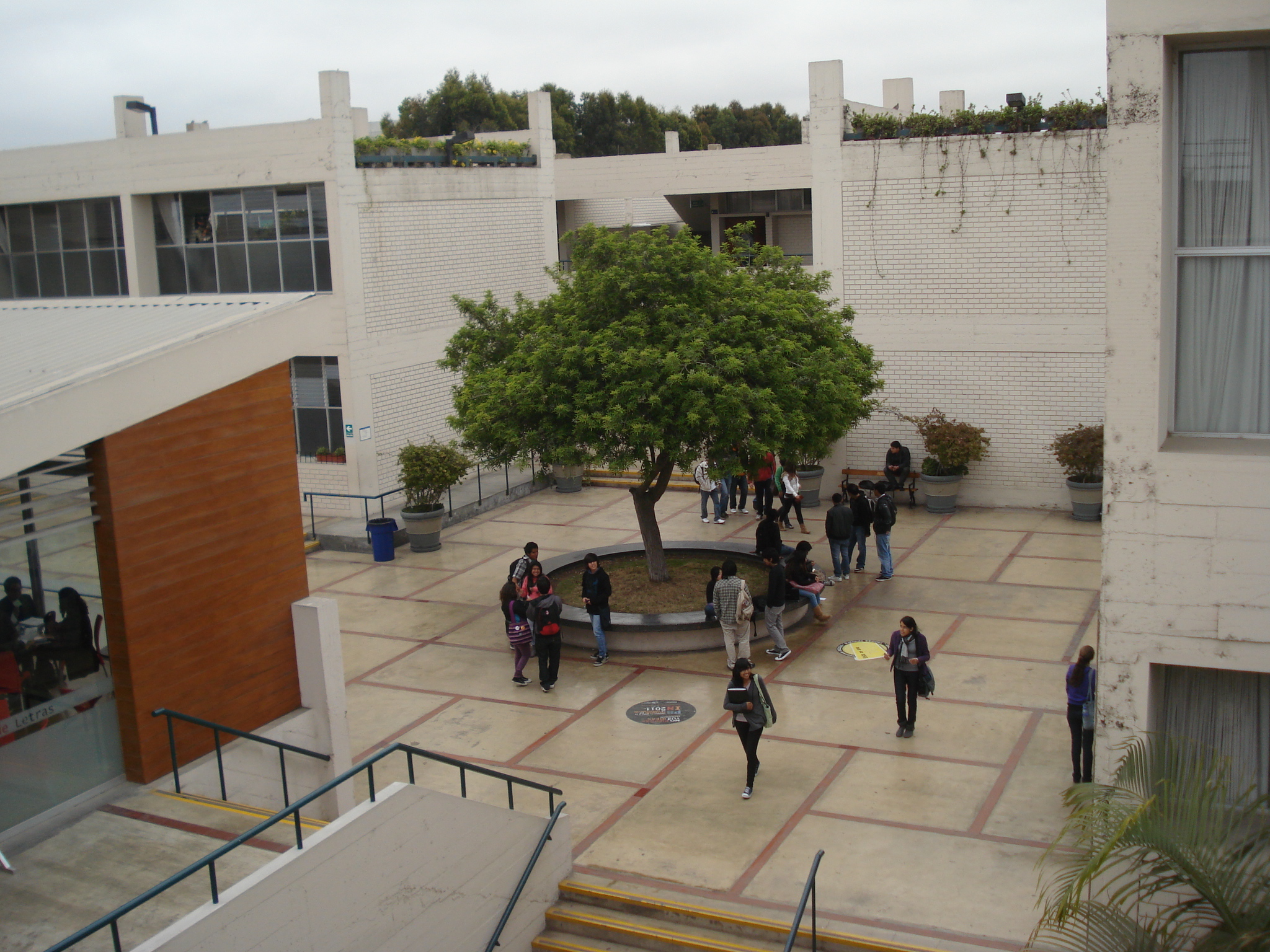
Going to school at the Pontificia Universidad Católica del Perú (la Católica) is a little bit different than Gustavus. Some things I like less, and some things I like more. If you’re curious about student life here, here’s a bit of comparison:
Before I get ahead of myself, I should let you know where I’m coming from. As a Gustie Spanish major and Curriculum II (Integrated core of gen eds) student, I’m used to a small Swedish-Lutheran liberal arts feel of campus. I am accustomed to small discussion-based classes, or at least a somewhat interactive lecture style in larger classes. And I’m accustomed to the lovely Gustavus Marketplace.
At la Católica, I am in the CIEE Liberal Arts program, taking two CIEE program courses (Peruvian Social Reality and Advanced Spanish: Writing Workshop) and several direct enrollment courses (Quechua, Contemporary Spanish Lit, Anthropological Activity II).
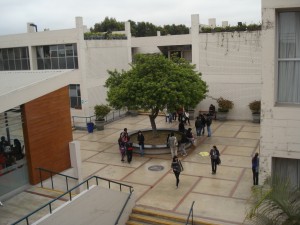
Ever since I first saw it, this tree looks to me like it should be the Tree of Life of PUCP. The round canopy, the sturdy trunk with the slight bend, the central location in the courtyard, in a little circle, the way students gather around it
First of all, as a rule of thumb in Latin America, university studies are much more career oriented, where Gustavus is more Liberal Arts oriented. I don’t know how far this extends, but it’s what I’ve seen in Chile, Peru, and we talked about it in my Latin American Cultures class. You choose a carrera (literally career of study) when you enter the school, and most if not all of your classes will focus on that career. In 4, or however many years, you will literally learn to be a doctor or a lawyer or an engineer or an architect, to name the big ones. Of course you choose a career you think you will be good at, that you will enjoy, but the goal is to learn a set of skills and knowledge to be ready to successfully jump into that career when you graduate. Arguably, students who have studied 4 years to be an X will be better prepared for that job than someone who has studied 2 years gen eds and 2 years X.
Compare that to Gustavus, where you roughly a third of your classes are gen eds, in many cases a third are electives, and many people decide on a major in their sophomore year. Someone might choose, for example, Spanish major (ehem). It broadens your cultural horizons and teaches knowledge and skills that could be useful in many places, but it is not a career. With a Spanish major, I will have to be trained in whatever career I take up, or go to grad school. Of course a Liberal Arts education can lead to a great career, and of course even Gustavus has more vocational majors such as Nursing, but a Liberal Arts education, as I see it, is about becoming a well-rounded, well-educated person.
Now I’m going to contradict myself: la Católica, as an exception in Latin America, is something of a Liberal Arts school. Students do choose a career at the start (I think?), but they have a year or two of Estudios Generales, where they have a smattering of language, math, science, etc., like Gustavus. There are arquitects and lawyers, but also there is a theology program, an arts program, anthropology and linguistics. All of which have wide career options, but don’t necessarily train you for a specific career. I still get funny looks from students who know what they’re going to do with their life, when I say, “yes I study Spanish” and “No, I’m not planning on teaching just yet.” But la Católica is definitely a Liberal Arts school.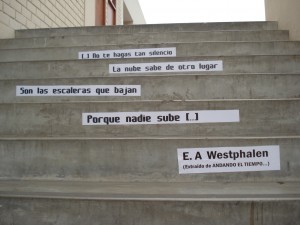
Class style at Gustavus, in my experience, is usually discussion-based, or at least a hybrid discussion and interactive lecture style. The one exception for me being a lecture-based Calculus class. At la Católica, on the other hand, my direct enroll classes are basically lecture style. Great professors who know their stuff and make it interesting, but still lectures.
Classes in Spanish can be tough, depending on how much you know when you arrive. All of my professors speak clearly and are easy to understand, but I have heard that some are more difficult. Overall, I think most international students pick up on their professors’ speech patterns fairly quickly. The harder thing is when readings are heavy, and when you have to write papers in Spanish. The CIEE Writing Workshop class is a good resource for improving your writing, but in essence, reading and writing are things you get better at gradually, by lots of practice.
In terms of studying, there is definitely less daily homework at la Católica. Professors assign readings, and I have to write reaction papers after visiting public spaces for my anthropology class. I had one lengthy Quechua worksheet. More so, you have to keep up on readings, take good notes, and rock the tests and final projects, because that is the base of your grade. It is a bit difficult for me, because typically at Gustavus, homework is most of my studying. Here, I have to create a study routine or I will not learn the material. But free time is abundant and flexible, as long as I start studying sometime…procrastination danger.
 I don’t think I can write a blog without mentioning food. I’m accustomed to the Gustavus caf, which is an ala carte system, grab food pay and eat, using a swipe card connected to a declining balance account. In the caf, you combine whatever foods you want, and you are at the cashier’s mercy for price. Pizza bagels! Salad bar on a sandwich! Soup over steamed veggies! Cereal on ice cream! Your monthly balance, which is prepaid and disappears if you don’t use it (choose your plan wisely), slowly declines as you swipe your card each day.
I don’t think I can write a blog without mentioning food. I’m accustomed to the Gustavus caf, which is an ala carte system, grab food pay and eat, using a swipe card connected to a declining balance account. In the caf, you combine whatever foods you want, and you are at the cashier’s mercy for price. Pizza bagels! Salad bar on a sandwich! Soup over steamed veggies! Cereal on ice cream! Your monthly balance, which is prepaid and disappears if you don’t use it (choose your plan wisely), slowly declines as you swipe your card each day.
Meanwhile, the Católica is more of a classic cafeteria style, cash-based economy, with an ala-carte area on the side. The CIEE norm is to tupperware what your host family cooked yesterday for lunch and microwave it at school. Microwaves are at each of the numerous cafs around campus. But as for the buying routine, from what I can tell, there are various set meals you can choose from. You pay the cashier, get a ticket, and then get in line for your food. The ala carte area also has a wide variety of foods: sandwiches, empanadas, snacks, cake, coffee. However, it’s also all premade and does not allow for much creativity. But try the Torta Hindú: spice cake (I think) covered with manjar blanco (dulce de leche, milk caramel). Soooo good.

On the day of the University council decision, on whether or not to comply with the cardinal's demands, hundreds of students, faculty, and family members gathered at the gates of the school to make their voice heard
The conception of public space is at La Católica is also somewhat different: the grass is a bit more…ornamental. The gardening crew waters it, students sit on it, the deer roam it, and that’s about it. The result is a beautiful campus with perfect lawns. On the contrary, Gustavus is a place where the grass is fair game for random frisbee and soccer games. I think I could get away with a frisbee passing circle at la Católica, but a soccer match would be frowned upon. There are spaces specifically designated for soccer, and the grass is not one of them. On the other hand, the deer and the squirrels are adorable.
Just how catholic is la Católica? It is historically catholic and is affiliated with the church. There are weekly chapel services on campus, as well as what seems to be catholic student organization. There is a theology department. Overall, it seems like you have the opportunity to live the catholic faith on campus, but it is by no means forced upon you.
Recently, a certain Cardinal Cipriani attempted to pressure la Católica to make changes, like giving the Cardinal the power to appoint people for certain positions.
It’s a power move, a part of larger tensions with la Católica. Some of the root issues are political differences with Cipriani. From what I’ve seen, the Católica is fairly left-leaning: My anthro prof teaches about racism and privilege. Among the faculty are openly gay, atheist, and socialist professors. On campus I see posters for the Vagina Monologues, there was a week themed “Invisibles,” focusing on the ongoing inequalities and challenges for creating an inclusive nation, particularly in regards to overpopulated prisons, maltreated empleadas (domestic workers), child laborers, Indians who were affected more heavily than anyone else by the violence in the years of Shining Path, Blacks, LGTB people, and the disabled.
So I don’t know details of the cardinal’s proposal, but I know that the University discourse has been constant in upholding the University’s autonomy, affirming that it is bound by Peruvian law, not Canon law, and that it intends to maintain itself as an environment of diversity of thought, while maintaining cordial dialogue with the church.
For me, it is reminiscent of Gustavus 2010, at the forum on civil discourse. I remember Gustavus Administration firmly stating that Gustavus is not a Christian school. It is affiliated with the Evangelical Lutheran Church of America, but it is primarily a College and will operate as such.
I hope this gives something of a glimpse into University life here. Comment or message if you have any questions.
Peace,
Ian
